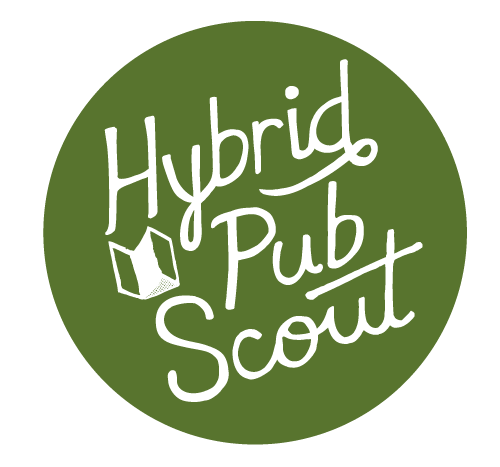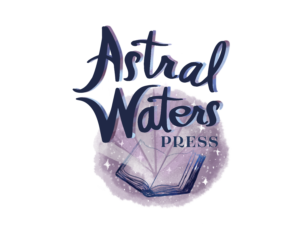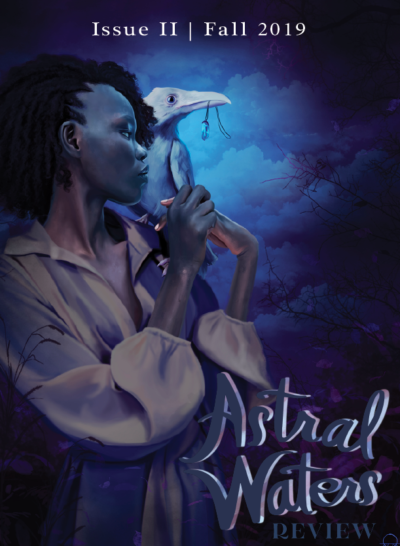by Amylia Ryan
How to bring a literary magazine into the world (and keep it alive for a while).
Astral Waters Review just published its second issue, wrapping up its first year in the digital lit mag world. As the founding editor and editor-in-chief of this fledgling publication, I’ve learned a lot about what goes into making a literary magazine and keeping it alive, even in its initial stages. These first two issues have provided plenty of lessons for future success—often the hard way.
How to Get Started with Your Own Lit Mag:
1. Have an Idea and Legitimize It
The idea for Astral Waters Review first came into existence as a grad school project, of all things. Tasked with creating a fake publishing company, a small group of us wanted to focus on speculative fiction, and we wanted it to be diverse. It made for a great project, so much so that even two years later, I was still thinking about how much I wanted it to be real.
I’ve read a lot of science fiction and fantasy in my life, and it didn’t take a lot of thought to notice a…trend…with the genres, historically. Quite frankly, both genres are overwhelmingly white, straight, and male. There are some fantastic exceptions, obviously, but the majority is still there. And I was tired of it (still am). I wanted a place I could go to specifically read speculative fiction by and about people of color and members of the LGBTQ community. I wanted to read speculative fiction that accurately addressed current social and political issues from the perspectives that are too often unheard and shut out. And I wanted to provide a platform for those perspectives.
So there was the idea. It was an idea that filled a specific hole in the literary world, or at least one that I saw. It fulfilled a specific need for at least one reader, with the hope that others would have that need as well.
An idea for a lit mag doesn’t have to skew political or social or didactic. It doesn’t have to try to change the world or even the genre. But if it’s going to see any sort of life, the idea needs to recognize some bit of market to squeeze into.
Once an idea is solidified, legitimize it. Come up with a great business name and register it. Get that sweet Employee Identification Number. Tell the government you exist and you’re not doing anything shady (this will be important when you start paying people/people start paying you and you have to file taxes). I registered my business name as Astral Waters Press because that’s the company under which Astral Waters Review is published. A magazine doesn’t have to be housed under a publisher; I just have lofty aspirations to someday publish books, too. And yes, all that official government business costs money.
2. If You Don’t Have Money, Get Some
I don’t like it any more than the next person, but publishing anything takes money. When I made the decision to start a lit mag, I had about $200 to make it happen. I was so sure that was enough. I just had to buy some publishing software and call it good, right?
So wrong. Still left to spend money on was:
- Domain name (annual payment)
- Website hosting (monthly payment)
- Logo/title design
- InDesign
- Advertising
- Contributors
Yes, you read that right. It was my intention from Day One to pay everyone involved with Astral Waters Review—except, probably, myself. More on that in a minute.
Marketing can be difficult and expensive, especially if you’re just starting out in your career, have a limited circle of connections, and are notoriously introverted. The best marketing tool I’ve utilized is the Astral Waters website. I built it on my own with Wix (great for beginners, and super affordable) and some basic coding knowledge. I’m not a professional web developer, and it probably shows, but I built the website in about a day and it looks alright and serves its intended function: to describe what the publication is and how to take part in it. That’s all a lit mag’s website needs to do. It’s not a terribly fancy business. But the website costs money, either monthly or annually, and it adds up fast.
I went back and forth for a few weeks on how I should get the rest of the money I needed. I had already spent a couple hundred bucks on website and legal stuff, so it was too late to go back. I thought about a personal loan for a while (hint: do not go into debt for a literary magazine, especially if you’re probably not going to get paid for a while).
The vast majority of literary magazines don’t pay their authors in real cash money; most new and emerging authors are only paid in publishing credits and a complimentary issue of the publication. And a sizable number of editors, especially at smaller operations, are volunteers. I have a lot of thoughts about this, but I’ll leave it at: I think people should get paid real cash money for their work. But, realistically, I didn’t foresee the magazine generating enough money to go around (note: this turned out to be accurate). So if I wanted to pay everyone else involved with the magazine, I’d likely have to put my own paycheck on hold for a while. Going into debt for this magazine wasn’t a smart option.
In the end, crowdfunding was my only viable option. Crowdfunding has been a fairly popular thing for literary magazines recently (especially niche ones), so I figured I’d give it a shot. In mid-November 2018, I launched a Kickstarter campaign. I made a few posts on my personal Facebook and Twitter accounts to help spread the word and put a few dollars toward a paid Facebook ad on the official Astral Waters account (more about that later). The campaign gained a little bit of attraction, and at one point was one of the top trending literary campaigns on Kickstarter for like ten minutes. I knew most of the backers personally, but a few of them were complete strangers, and that surprised me. And on December 31st, the campaign ended at 118% funded. It made enough money to fund the magazine through its first year. Or so I thought.
3. Get Some Help
One of the biggest things I learned early on (like, a week before the Kickstarter campaign) is that one person running a magazine simply isn’t feasible. I had a massive to-do list. All of the website building, marketing, designing, emailing, slush pile reading, and copy editing required to create and run a lit mag fell solely on me.
So I got help. My professional circle may be small, but it’s mighty. The first person I needed was a designer. I can’t draw for squat, and I wanted an illustrated look to the magazine’s title and logo. A former grad school classmate of mine happens to create some of the most adorable illustrations I’ve ever seen, and thankfully she was available to design something for me.
Then, as much as I love editorial work, I decided I needed more editors on board. I work as a content editor at my 9–5, and I’m also a freelance book editor on the side. My editorial plate is full. So I approached two very dear friends (also former classmates) whose editorial skills I trust and who I knew were spec fic fans to help read through submissions and copy edit/proofread the accepted pieces.
And now, the completion of the second issue has shown me that my marketing skills are mediocre at best, and I need more help. With any luck, I’ll be able to find someone to help out with marketing efforts in time for Issue III in May.
4. Advertise
I’ll be honest. The “marketing” I did for the first issue was abysmal. I paid Facebook $60 to run an ad for ten days. That campaign gained maybe a dozen likes for the Astral Waters Facebook page. I tried sharing some posts on Twitter and Instagram, but my limited circle meant those posts gained no traction. Then, embarrassingly, I thought it would be a good idea to post physical flyers only around my immediate neighborhood. I spent more money than I should have to print full-color 8.5” x 11” posters and put them up in cafes and indie shops up and down the closest major cross street. It’s safe to assume how few submissions and issue purchases I got from that. (It was zero).
I was being frugal with the crowdfund money. After a couple of months post-Issue I, I had to finally admit to myself that the crowdfund money wasn’t going to last through Issue II. After paying the authors, artists, and assistant editors from Issue I, I spent the last $400 on advertising with Lambda Literary. The response from that ad was so overwhelming, I nearly ran out of time to read all the submissions for Issue II. The growth in submissions and readership was astounding. It’s what I had hoped to get for the first issue, but never achieved. Lesson learned.
5. Keep Growing
I’m sure I’ll learn more lessons with every issue. And with every issue, the magazine will keep growing. For the near future, I plan to grow marketing efforts even more. I also hope to partner with community organizations that mirror my mission to support diversity and underrepresented writers. I know it’ll take a lot more money, but that’s an area to explore, too. While the Kickstarter was a success, the magazine shouldn’t rely on crowdfunding for every issue. It’s not sustainable. Many literary magazines are sustained by arts funding and grants from their local government or money from industry awards (like the Firecracker Award from the Community of Literary Magazines and Presses), and applying for that sort of funding will be a key focus of mine in the time between Issues II and III.
Starting a literary magazine (and keeping it going) isn’t easy, but the challenges have only provided opportunities for growth for Astral Waters Review. I’m so excited to keep learning valuable lessons and bringing diverse voices to the speculative fiction stage, and I hope to see you on the mailing list (check the bottom of the Astral Waters Review homepage to sign up!).




